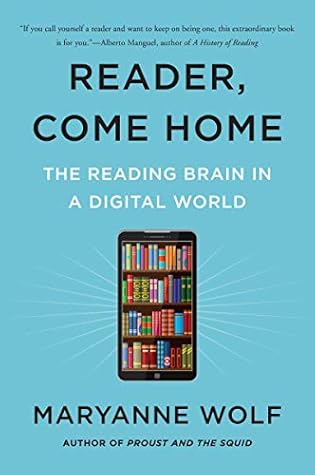More on this book
Community
Kindle Notes & Highlights
The acquisition of literacy is one of the most important epigenetic achievements of Homo sapiens.
The act of learning to read added an entirely new circuit to our hominid brain’s repertoire. The long developmental process of learning to read deeply and well changed the very structure of that circuit’s connections, which rewired the brain, which transformed the nature of human thought.
Given their more particular worries, many parents and grandparents have asked me the equivalent of Kant’s three questions14: What do we know? What should we do? What can we hope?
the heart of the reading act, going beyond the wisdom of the author to discover one’s own.
Anyone who still believes the archaic canard that we use only a tiny portion of our brains hasn’t yet become aware of what we do when we read. Circuit du Soleil If we as a society are to grapple with the full implications of the ongoing changes to our plastic reading brain, we need to get “under the hood” of the reading circuit.
The act of taking on the perspective and feelings of others is one of the most profound, insufficiently heralded contributions of the deep-reading processes.
In reading research, the cognitive psychologist Keith Stanovich suggested something similar some time ago about the development of word knowledge. In childhood, he declared, the word-rich get richer and the word-poor get poorer, a phenomenon he called the “Matthew Effect”41 after a passage in the New Testament. There is also a Matthew-Emerson Effect for background knowledge: those who have read widely and well will have many resources to apply to what they read; those who do not will have less to bring, which, in turn, gives them less basis for inference, deduction, and analogical thought and
...more
Rachael liked this
Getting to the truth of things—whether in science, in life, or in text—requires observation, hypotheses, and predictions based on inference and deduction, testing and evaluation, interpretation and conclusion, and when possible, new proof of these conclusions through their replication.
There are both poetry and science at the heart of reading.
In common things that round us lie2 Some random truths he can impart, —The harvest of a quiet eye. —William Wordsworth
I read both to find fresh reason to love this world and also to leave this world behind—to
As the philosopher Charles Taylor notes, “The crucial condition for human language6 learning is joint attention,” which he and others who are involved in studying the ontogenesis of language consider one of the most important features of human evolution.
arcia/tl (attend, remember, connect, infer, analyze/then LEAP!)
“I can, with one eye squinted,37 take it all as a blessing.”
“rhythm of time that passes with no other aim12 than to let feelings and thoughts settle down, mature, and shed all impatience or ephemeral contingency.” He used the Latin expression festina lente, which translates as “hurry slowly” or “hurry up slowly,” to underscore the writer’s need to slow time. I use it here to help you experience the third life more consciously: knowing how to quiet the eye and allow your thoughts to settle and be still, poised for what will follow.
his evocative concept of pharmakon, a “remedy that contains a poison with a therapeutic virtue,” has helped to sharpen my own perspective on technology’s complex contributions to society.
We die. That may be the meaning of life. But we do language. That may be the measure of our lives. —Toni Morrison


